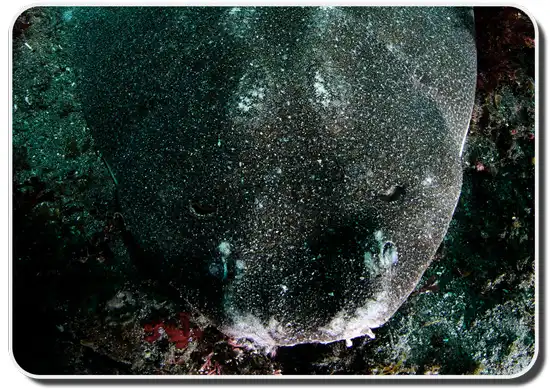 The Japanese angelshark is a bottom-dwelling shark easily recognizable from the flattened pectoral fins on the side of its head that look like wings.
The Japanese angelshark is a bottom-dwelling shark easily recognizable from the flattened pectoral fins on the side of its head that look like wings.
Japanese Angelshark Scientific Classification |
|
| Kingdom | Animalia |
| Phylum | Chordata |
| Class | Chondrichthyes |
| Order | Squatiniformes |
| Family | Squatinidae |
| Genus | Squatina |
| Scientific Name | S. japonica |
Description
These sharks range from 4.9 to 8.2 ft, with a flat appearance similar to rays. The eyes are oval, and the large nostrils have a minor skin flap with two barbels. Inside the mouth, there are ten rows of teeth on both jaws.
The pectoral fins form a triangular lobe separate from the head, while the pelvic fins have convex margins. The two dorsal fins are angular in shape, located right behind the pelvic fins.
Japanese angelsharks are light to dark brown from above, covered with squarish dark spots that become sparser from the center to the fins. When looked at ventrally, they are pale with greater mottling.
Where do they live
Map Of The Japanese Angelshark’s Habitat

As its name suggests, the Japanese angelshark is found in the waters of Honshu, Japan. However, its range encompasses a lot more of the northwestern Pacific, including the East China Sea, the southern Sea of Japan, the Taiwan Strait, and the Yellow Sea.
It lives primarily in shallow waters but has been spotted at depths of 980 ft. A bottom dweller, this shark swims over rocky reefs or sandy bottoms.
Behavior
Feeding
These sharks feed on cephalopods, crustaceans, and demersal fish.
Reproductive
Japanese angelsharks are viviparous, giving live birth to a litter of 2-10 pups in spring and summer. Initially, they are 8.7 inches long, with the females becoming sexually mature when they are 31 inches long. The sexual maturity of the males remains unknown.
 Adaptations
Adaptations
The coloration and spots of this shark provide excellent camouflage against predation.
Interactions with humans
Japanese angelsharks are often frequently caught – both intentionally and as bycatch – with their meat being consumed and their skin being turned into a form of leather used in wood finishing called shagreen. As a result of these fishing activities over its small range, its population has declined by 50% in certain parts leading to the IUCN classifying this shark as “Critically Endangered” or “CR”.
It is pretty docile towards humans, though it can deliver a powerful bite if irritated.
